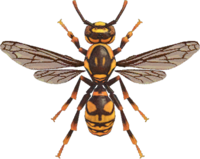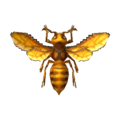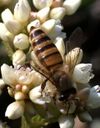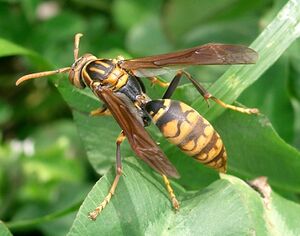Wasp
- "OWWWW! I got stung by a bee..." —Animal Crossing (Stung by bees)
- "I got stung by BEES! Ow! Ow ow ow ow!" —Wild World (Stung by bees)
- "I got stung by a bee! Ow! Ow ow ow!" —City Folk (Stung by bees)
- "Ow! Ow ow ow... I got stung by bees!" —New Leaf (Stung by bees)
- "Ow! Ow ow ow... I got stung by wasps!" —New Horizons (Stung by wasps)
| ||||||
 | ||||||
| Real-world info | ||||||
|---|---|---|---|---|---|---|
| Name: Unknown Family: Unknown | ||||||
| Main appearances | ||||||
|
| ||||||
| Other appearances | ||||||
Names in other languages
ハチ
벌 Vespa Wespe
黄蜂
Guêpe Avispa Wesp
黃蜂 Guêpe Avispa Оса | ||||||
The Wasp[nb 1] (known as the Bee prior to New Horizons) is a harmful bug in the Animal Crossing series introduced in Doubutsu no Mori. Wasps are found in trees, when shaken, and they will chase the player and sting them if not caught in time. If stung, the player's left eye swells. In Animal Crossing: New Horizons, if the player is stung by another wasp while still swollen, they will pass out and be returned to their house. If they are on a Mystery Island and they are stung twice, they will return to Wilbur at the dock.
If the player's gates are open or if multiplayer is active, harmful bugs, including Wasps, will not appear.
The player can be healed either with medicine or by simply saving and ending the game. Villagers will remark on a stung player's appearance if the player has been stung, with normal villagers reacting in fright or concern and snooty villagers chiding the player for that attack (adding insult to injury); while cranky villagers can outright laugh at the player. In New Leaf, sisterly villagers will act concerned for the player, and will give them medicine if they are stung, even if the villager is currently sick. If a Wasp Nest falls from a tree and the player goes to talk to a villager, the villager will notice the wasps in the air and say something in fear such as, "Get away from me!"
Catch details
In Animal Crossing
In Wild World
| Description | These dangerous bugs are yellow and black. |
|---|---|
| Time of year | Unknown |
| Time of day | All year: All day |
| Peak times | |
| Location | In trees |
| Bug size | 38 mm |
| Selling price | |
| Furniture size |
In City Folk
| Description | These poison-carrying bees will attack big foes to protect the queen. |
|---|---|
| Time of year | Unknown |
| Time of day | All year: All day |
| Peak times | |
| Location | In trees |
| Bug size | About 38 mm |
| Selling price | |
| Furniture size |
In New Leaf
| Time of year | Unknown |
|---|---|
| Time of day | All year: All day |
| Peak times | |
| Location | In trees |
| Size | 30 mm |
| Selling price | |
| Furniture size |
In New Horizons
| Time of year | North: All year South: All year |
|---|---|
| Time of day | All day |
| Location | Shaking trees |
| Weather | Any weather |
| Spawn requirement | Appears from the start of the game |
| Selling prices | |
| Furniture size |
Donating to the museum
In Animal Crossing
"Why, I'd imagine it took more than a bit of skill and daring to catch bees! You've got 'moxie,' as I believe they say. I'm certain you must have been stung numerous times. How terribly painful that must have been, eh wot? Incidentally, do you know how some honeybees protect their hives when attacked by giant wasps? The giant wasps can't survive heats above 113 degrees, but the honeybees can live at heats up to 122 degrees. The canny honeybees use this nine-degree difference to their fullest advantage, wot! When the wasps arrive, the bees attack them en masse. A single wasp may be swarmed by up to 500 bees! Now this is truly amazing. The bees then begin to vibrate, creating a veritable cocoon of suffocating heat. Do you see the genius at work here? This swarming is but a feverish defense against the giant wasps' weakness. The temperature? Hoo hoo! Lo and behold, 120 degrees! Just below the bees own threshold of survival! In this incredible fashion, the honeybees literally lay their lives on the line to protect the hive. Stupendous! To be honest, I learned that from a wee documentary I saw on the telly! Of course, incredible feats go only so far. When all is said and done, they're still insects, and still ghastly!"
In Wild World
"I once thought that its stinger was a bee's lone defense, but... ...I've recently heard that they also possess terribly replusive breath! Of course, the gent who told me this was a bit of a rabit liar, but still! I would heartly endorse the following action if you see another: FLEE LIKE MAD! Stingers and bad breath, honestly! What monstrous little beasties..."
In City Folk
"It can be quite dangerous to receive a large dose of bee venom-- for example, by being stung. That said, did you know that same substance is actually used in some women's perfumes? Indeed! A potent venom and a potent perfume... Which do you suppose is more devastating, wot?"
The Bee can be found flying from tree to tree along the back wall of the museum's insect exhibit.
In New Leaf
Upon being donated, the Bee can be found in the room of the bug exhibit with the light in, flying around and resting on a tree in the back. The exhibit has this to say about the Bee:
"Bees are prone to attack anyone who comes too close to their hive, so be careful when approaching! The yellow and black you see on their bodies are colors often used to convey danger. This danger is pretty significant, as many varieties of bees are capable of stinging multiple times."
In New Horizons
Upon donating the wasp to the museum the curator, Blathers, will say the following:
- "Hoo! Allow me to share a fact with you! Wasps are sometimes called "meat bees" because...They. Eat. MEAT! MEAT! Of almost any sort! Surely you've seen what a menace they make of themselves at picnics. 'Tis hardly the worst of it, wot wot! Aggressive predators with venomous stingers, wasps not only hunt and eat other insects... they paralyze their prey, then drag their victims home ALIVE, leaving them for their larva to feed upon. Suddenly a simple sting seems quite tolerable."
Gallery
Real-world information
Prior to New Horizons
Apis cerana japonica, the Asiatic honey bee, is a hardy species of bee that originates from South-Eastern Asia. It is used commercially for its honey, despite having a smaller yield than its European counterpart, Apis mellifera. Mellifera has, however, been subject to selective breeding for many centuries, greatly increasing honey output over the years.
It is unknown whether the Wasp in the Animal Crossing series is meant to be based on the Asiatic honey bee or the Japanese giant hornet, as the bee's Japanese name, hachi, can refer to both bees and wasps interchangeably. The Bee's in-game design in Animal Crossing: City Folk and Animal Crossing: New Leaf is more similar to the Japanese giant hornet, and the beehives seen in-game bear closer resemblance to a hornet's nest than to a real-world honeycomb, while in Animal Crossing: New Horizons, the insect's design is closer to a European paper wasp, a species more widely recognized as a wasp rather than a bee outside of Japan.
In New Horizons
Polistes dominula, the European paper wasp, is a species of wasp that originates from Europe, North Africa, and southeast and eastern Asia. Like the Asiatic honey bee, the European paper wasp is a social species, congregating in large hives composed of numerous interlinked hexagonal cells not unlike those of a honeycomb; rather than being made from natural wax, however, these hives are constructed of paper, created by chewing wood into pulp and spitting it out, hence the name "paper wasp." A special protein in the wasps' saliva toughens and waterproofs the pulp, allowing the hives to maintain shapes like that seen in the Animal Crossing series and ensuring greater protection from predators.
Names in other languages
| ハチ hachi |
Hymenopteran (can refer to bees, wasps, sawflies, etc.) | |
| 벌 beol |
Wasp | |
| 黄蜂 huángfēng |
Wasp | |
| 黃蜂 Unknown |
||
| Оса Osa |
Wasp | |
| Wesp | Wasp | |
| Wespe | Wasp | |
| Avispa | Wasp | |
| Guêpe | Wasp | |
| Vespa | Wasp | |
Notes
| Bugs | |||||||||||||||||||
|---|---|---|---|---|---|---|---|---|---|---|---|---|---|---|---|---|---|---|---|
| |||||||||||||||||||




